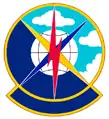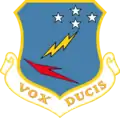Survivable Low Frequency Communications System
The AN/FRC-117 Survivable Low Frequency Communications System (SLFCS) was a communications system designed to be able to operate, albeit at low data transfer rates, during and after a nuclear attack.[1] The system used both very low frequency (VLF), and low frequency (LF) radio bands.
Mission
SLFCS was used for United States nuclear forces' command and control communications for Emergency Action Message dissemination and force direction. Single channel, receive only capability was provided at ICBM launch control centers. The single channel operated between 14 kHz and 60 kHz to receive commands from remotely located Combat Operations Center – Transmit/Receive (T/R) sites; this low frequency range is only slightly affected by nuclear blasts.
SLFCS' primary advantage was that it would experience minimal radio signal degradation as a result of nuclear detonations. It would be an alternate means of communication during and after detonations, providing a survivable command and control communications network for the Strategic Air Command (SAC), the Joint Chiefs of Staff (JCS), and North American Aerospace Defense Command (NORAD). SLFCS would also relay signals from the Navy's LF/VLF systems.
Locations
Transmitters
- Silver Creek, Nebraska (1st Aerospace Communications Group)
- Hawes Air Force Station, California (Det 2, 33rd Communications Squadron)
- PACCS aircraft
- NAOC (formerly known as NEACP)
GREEN PINE Stations
The GREEN PINE communication system took messages broadcast over SLFCS and 'upconverted' them to UHF messages for bombers headed north. There were a handful of GREEN PINE stations in the northern portions of Alaska and Canada.[2][3]
Receive Only
- Altus AFB, Oklahoma
- Barksdale AFB, Louisiana (8th Air Force Command Post)
- Beale AFB, California (9 SRW Command Post)
- Blytheville AFB, Arkansas (97 BW Command Post)
- Carswell AFB, Texas (7 BW Command Post)
- Castle AFB, California (93 BW Command Post)
- Davis-Monthan AFB, Arizona - 390th SMW (18 LCCs) CLOSED
- Dyess AFB, Texas (96 BW Command Post)
- Eielson AFB, Alaska (6 SW Command Post)
- Ellsworth AFB, South Dakota - 44th SMW (16 terminals - 15 LCCs and Wing Command Post) CLOSED
- Fairchild AFB, Washington
- F.E. Warren AFB, Wyoming - 90th Missile Wing, 20th Air Force (21 terminals- 20 LCCs, 1 at 20th AF Missile Operations Center)
- Grand Forks AFB, North Dakota - 321st SMW (16 terminals - 15 LCCs and Wing Command Post) CLOSED
- Griffiss AFB, New York CLOSED
- Grissom AFB, Indiana
- K.I. Sawyer AFB, Michigan CLOSED
- Little Rock AFB, Arkansas - 308th SMW (18 LCCs) CLOSED
- Loring AFB, Maine (42 BW Command Post) CLOSED
- Rickenbacker AFB, Ohio
- Malmstrom AFB, Montana 341st SMW (20 terminals - 20 LCCs)
- Mather AFB, California
- McConnell AFB, Kansas 22 BW (Command Post), 381st SMW (18 LCCs) CLOSED
- Minot AFB, North Dakota (5 BW/91 SMW 15 LCCs)
- Pease AFB, New Hampshire (509 BW Command Post) CLOSED
- Plattsburgh AFB, New York (380 BW Command Post) CLOSED
- Robins AFB, Georgia (19 BW Command Post)
- Seymour Johnson AFB, North Carolina (68 BW Command Post)
- Travis AFB, California
- Vandenberg AFB, California (1 STRAD Command Post)1 LCC O1A
- Whiteman AFB, Missouri - 351st SMW (16 terminals - 15 LCCs and Wing Command Post) CLOSED
- Wurtsmith AFB, Michigan (379 BW Command Post)
- March AFB, California (15th AF COC)
History
The first program (487L) took six years from the time of the initial requirement to full operation. The second part (616A), which was basically a modification of an already operational system, took 10 years.
Chronology
- 1961
- 29 Sep – Headquarters USAF issues Specific Operating Requirement 193, for the Survivable Low Frequency Communications System; system is envisioned to link Alternate Joint Command Center with command centers of SAC, NORAD, SAC numbered air forces with LF radio networks; a total of 18 transmit/receive (T/R) sites and 375 LF-receive only (R/O) in all SAC launch facilities, mobile Minuteman trains, SAC air base control rooms, and SAC UHF positive control stations in the northern tier
- 1962
- 12 Mar – Amendment to SOR 193 changes number of transmit T/R sites to 19 (three each at AJCC, SAC, NORAD, two each at 2d Air Force, 15th Air Force and 8th Air Force, one each at Larson AFB, Southern Alaska, Sondrestrom AB, and the United Kingdom; Full Operating Capability was extended from July 1964 to May 1965.
- 27 Apr – A revised program directive delineated the network; T/R equipment would be installed at HQ SAC, the SAC numbered air force headquarters, and in the ABNCP, Alternate Joint Command Center (AJCC) and NORAD command center. 14 Green Pine stations, missile launch control centers, all SAC bomber wing command posts would have R/O terminals, as would the NORAD regional control centers. Initial Operating Capability (IOC) was placed at 1 Oct 1966.
- 1968
- 1971
- 16 Jun – SLFCS IOC obtained by SAC units
- 1974
- 1978
- SAC conducts Initial Operational Test and Evaluation (IOT&E) at Ellsworth AFB, South Dakota for Program 616A; test is successful
- 1986
- 30 Sep – deactivation of Hawes Radio Relay Site, Hinkley, California
- 20 Oct – destruction of Hawes Radio Relay Site by the Army Corps of Engineers
- 1996
- Rapid Execution and Combat Targeting (REACT) upgrade to Minuteman launch control centers complete; advances allow SLFCS messages to be handled automatically by Higher Authority Communications/Rapid Message Processing Element (HAC/RMPE)[5]
- 2005
- 11 Nov – last Minuteman Launch Control Center receives Minimum Essential Emergency Communications Network (MEECN) upgrade, rendering SLFCS obsolete.[6]
- 2010 MMP – Minuteman Minimum Essential Emergency Communications Network Program now in the upgrade portion. Work In Progress. Advanced EHF will be available once upgrade is complete.
Photo gallery
 33d Comm Squadron, Hawes AFS, California
33d Comm Squadron, Hawes AFS, California 1st Aerospace Comm Group, Offutt AFB, Nebraska
1st Aerospace Comm Group, Offutt AFB, Nebraska
See also
| Wikimedia Commons has media related to Survivable Low Frequency Communications System. |
- Post Attack Command and Control System (PACCS)
- Ground Wave Emergency Network (GWEN)
- Minimum Essential Emergency Communications Network (MEECN)
- Emergency Rocket Communications System (ERCS)
- Hawes Radio Tower – Location of the West Coast SLFCS transmitter until the mid-1980s at Hawes field
- Silver Creek Communications Annex – Location of the East Coast SLFCS transmitter until the mid-1990s
References
- GlobalSecurity.org (2005-04-28). "Survivable Low Frequency Communications System (SLFCS) – United States Nuclear Forces". Retrieved 2007-10-04.
- Strategic Air Command Regulation 100-24 Vol III: SAC Communications System Operations/EWO Support Requirements, 6 Jul 1979
- Santa Barbara Amateur Radio Club Key Klix: "Survivable LF Comm System", April 2008, Vol 55, No. 4
- Air Force Historical Research Agency: "History of 3902d Air Base Wing, July – September 1968"
- Selnick, D., "Higher Authority Communications/Rapid Message Processing Element (HAC/RMPE)", 2002
- Air Force Space Command: "Minot completes final MEECN modifications", 17 Nov 2005 Archived 24 March 2010 at the Wayback Machine